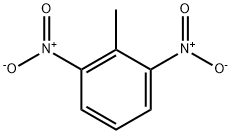2,6-디니트로톨루엔
|
|
2,6-디니트로톨루엔 속성
- 녹는점
- 56-61 °C(lit.)
- 끓는 점
- 300°C
- 밀도
- 1.2833
- 증기압
- 3.5(x 10-4 mmHg) at 20 °C (quoted, Howard, 1989)5.67(x 10-4 mmHg) at 25 °C (Banerjee et al., 1990)
- 굴절률
- 1.4790
- 인화점
- 207°C
- 저장 조건
- 2-8°C
- 용해도
- Soluble in ethanol (Weast, 1986) and many other organic solvents including chloroform and carbon tetrachloride.
- 수용성
- 0.0182g/100mL
- BRN
- 2052046
- 안정성
- 안정적이지만 충격에 민감합니다. 산화제, 환원제, 강염기와 호환되지 않습니다. 가열하면 폭발할 수 있습니다.
- CAS 데이터베이스
- 606-20-2(CAS DataBase Reference)
- IARC
- 2B (Vol. 65) 1996
안전
- 위험 및 안전 성명
- 위험 및 사전주의 사항 (GHS)
| 위험품 표기 | T,F | ||
|---|---|---|---|
| 위험 카페고리 넘버 | 45-23/24/25-48/22-52/53-62-68-39/23/24/25-11-36-20/21/22 | ||
| 안전지침서 | 53-45-61-456-36/37-26-16 | ||
| 유엔번호(UN No.) | UN 3454 6.1/PG 2 | ||
| WGK 독일 | 3 | ||
| RTECS 번호 | XT1925000 | ||
| TSCA | Yes | ||
| 위험 등급 | 6.1 | ||
| 포장분류 | II | ||
| HS 번호 | 29049090 | ||
| 유해 물질 데이터 | 606-20-2(Hazardous Substances Data) | ||
| 독성 | Acute oral LD50 for mice 621 mg/kg, rats 177 mg/kg (quoted, RTECS, 1985). | ||
| 기존화학 물질 | KE-23777 | ||
| 유해화학물질 필터링 | 2014-1-695 | ||
| 함량 및 규제정보 | 물질구분: 유독물질; 혼합물(제품)함량정보: 디니트로톨루엔[Dinitrotoluene; 25321-14-6, 121-14-2, 606-20-2, 610-39-9, 602-01-7, 619-15-8, 618-85-9] 및 이를 0.1% 이상 함유한 혼합물 |
2,6-디니트로톨루엔 C화학적 특성, 용도, 생산
화학적 성질
2,6-Dinitrotoluene is one of the six dinitrotoluene isomers. Dinitrotoluene (DNT) or Dinitro is an explosive with the formula C6H3(CH3)(NO2)2. At room temperature it is a pale yellow to orange crystalline solid. It is a high explosive and one of the precursors for trinitrotoluene (TNT), which is synthesized through three separate nitrations of toluene. The first product is mononitrotoluene, DNT is the second, and TNT is the third and final product.물리적 성질
Pale yellow, orange, brown or reddish rhombic crystals. Odor threshold concentration in water is 100 ppb (quoted, Keith and Walters, 1992).용도
2,6-Dinitrotoluene is used primarily, along with the other isomers, in producing toluene diisocyanate; production of the diisocyanate ranges from 100 million to almost a billion pounds each year.정의
ChEBI: 2,6-dinitrotoluene is a dinitrotoluene carrying nitro substituents at positions 2 and 6. It has a role as a genotoxin.제조 방법
2,6-Dinitrotoluene is synthesized from o-nitrotoluene by nitration with mixed acid.일반 설명
Yellow to red solid or heated liquid with a slight odor. Solidifies in cool water. Solid and liquid sink in water.공기와 물의 반응
Mixes slowly with water. Insoluble in water.반응 프로필
2,6-Dinitrotoluene is sensitive to heat. 2,6-Dinitrotoluene may explode when exposed to heat or flame. 2,6-Dinitrotoluene can be detonated only by a very strong initiator. 2,6-Dinitrotoluene is incompatible with strong oxidizers. 2,6-Dinitrotoluene is also incompatible with caustics and metals such as tin and zinc. 2,6-Dinitrotoluene may react with reducing agents. 2,6-Dinitrotoluene will attack some forms of plastics, rubber and coatings.건강위험
INHALATION, INGESTION OR SKIN ABSORPTION: Headache, weakness, nausea or dizziness, cyanosis, drowsiness, shortness of breath and collapse. Can burn eyes and skin.Safety Profile
Poison by ingestion. A skin irritant. Questionable carcinogen with experimental tumorigenic data. Mutation data reported. When heated to decomposition it emits toxic fumes of NOx. See also 2,4-DINITROTOLUENE환경귀착
Biological. When 2,6-dinitrotoluene was statically incubated in the dark at 25 °C with yeast extract and settled domestic wastewater inoculum, significant biodegradation with gradual acclimation was followed by deadaptive process in subsequent subcultures. At a concentration of 5 mg/L, 82, 55, 47, and 29% losses were observed after 7, 14, 21, and 28-d incubation periods, respectively. At a concentration of 10 mg/L, only 57, 49, 35, and 13% were observed after 7, 14, 21, and 28-d incubation periods, respectively (Tabak et al., 1981). Under anaerobic and aerobic conditions, a sewage inoculum degraded 2,6-dinitrotoluene to aminonitrotoluene (Hallas and Alexander, 1983).Photolytic. Simmons and Zepp (1986) estimated the photolytic half-life of 2,6-dinitrotoluene in surface water to range from 2 to 17 h.
Low et al. (1991) reported that the nitro-containing compounds (e.g., 2,4-dinitrophenol) undergo degradation by UV light in the presence of titanium dioxide yielding ammonium, carbonate, and nitrate ions. By analogy, 2,6-dinitrotoluene should degrade forming identical ions.
Chemical/Physical. 2,6-Dinitrotoluene will not hydrolyze (Kollig, 1993).
At influent concentrations of 1.0, 0.1, 0.01, and 0.001 mg/L, the GAC adsorption capacities were 145, 70, 33, and 16 mg/g, respectively (Dobbs and Cohen, 1980).








